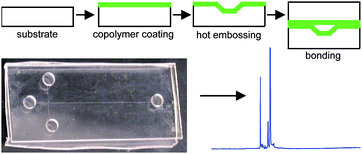A general microchip surface modification approach using a spin-coated polymer resist film doped with hydroxypropyl cellulose
Abstract
We have developed a simple and effective method for surface modification of

* Corresponding authors
a
Department of Chemistry and Biochemistry, Brigham Young University, Provo, Utah, USA
E-mail:
atw@byu.edu
Fax: +1-801-422-0153
Tel: +1-801-422-1701
We have developed a simple and effective method for surface modification of

 Please wait while we load your content...
Something went wrong. Try again?
Please wait while we load your content...
Something went wrong. Try again?
X. Sun, W. Yang, Y. Geng and A. T. Woolley, Lab Chip, 2009, 9, 949 DOI: 10.1039/B815069A
To request permission to reproduce material from this article, please go to the Copyright Clearance Center request page.
If you are an author contributing to an RSC publication, you do not need to request permission provided correct acknowledgement is given.
If you are the author of this article, you do not need to request permission to reproduce figures and diagrams provided correct acknowledgement is given. If you want to reproduce the whole article in a third-party publication (excluding your thesis/dissertation for which permission is not required) please go to the Copyright Clearance Center request page.
Read more about how to correctly acknowledge RSC content.
 Fetching data from CrossRef.
Fetching data from CrossRef.
This may take some time to load.
Loading related content
